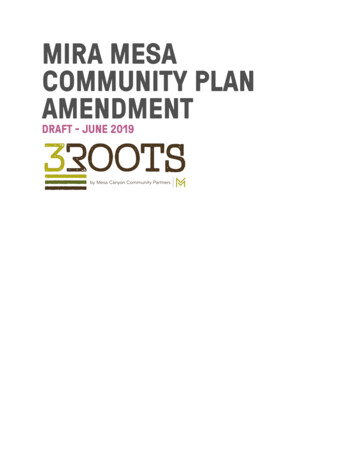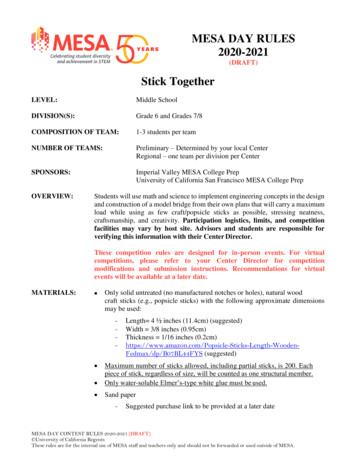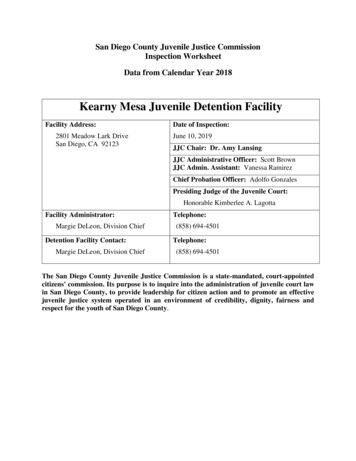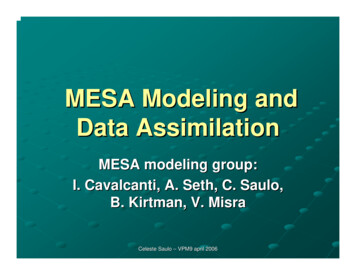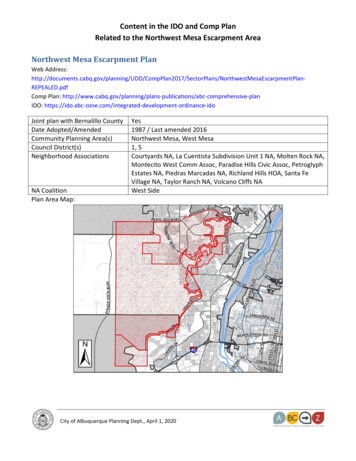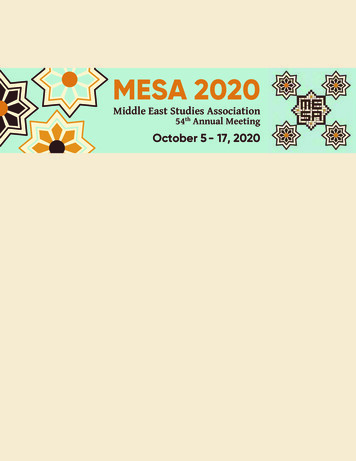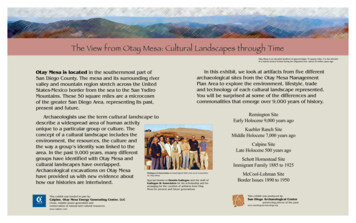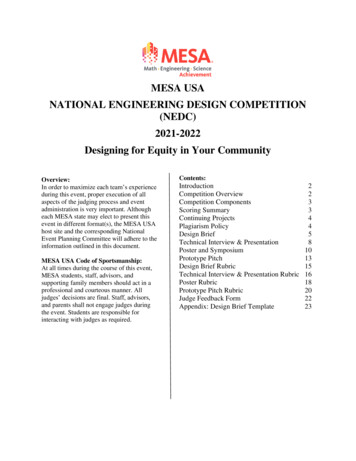
Transcription
MESA USANATIONAL ENGINEERING DESIGN COMPETITION(NEDC)2021-2022Designing for Equity in Your CommunityOverview:In order to maximize each team’s experienceduring this event, proper execution of allaspects of the judging process and eventadministration is very important. Althougheach MESA state may elect to present thisevent in different format(s), the MESA USAhost site and the corresponding NationalEvent Planning Committee will adhere to theinformation outlined in this document.MESA USA Code of Sportsmanship:At all times during the course of this event,MESA students, staff, advisors, andsupporting family members should act in aprofessional and courteous manner. Alljudges’ decisions are final. Staff, advisors,and parents shall not engage judges duringthe event. Students are responsible forinteracting with judges as required.Contents:IntroductionCompetition OverviewCompetition ComponentsScoring SummaryContinuing ProjectsPlagiarism PolicyDesign BriefTechnical Interview & PresentationPoster and SymposiumPrototype PitchDesign Brief RubricTechnical Interview & Presentation RubricPoster RubricPrototype Pitch RubricJudge Feedback FormAppendix: Design Brief Template223344581013151618202223
2021-2022 MESA USANational Engineering Design CompetitionDesigning for Equity in Your CommunityIntroductionSimply stated, Designing for Equity means designing to minimize or eliminate barriers toopportunities for success. Designing for equity in your community allows the opportunity tothink globally and act locally.According to the World Health Organization, equity is the absence of avoidable or remedialdifferences. Those differences can be defined socially, physically, physiologically, geographically,economically, or demographically. Given the current state, Designing for Equity in Your Communityhas never been more important.The Creative Reaction Lab, explains that “Equity-Centered Community Design is a unique creativeproblem solving process based on equity, humility-building, integrating history and healingpractices, addressing power dynamics, and co-creating with the community. This design processfocuses on a community’s culture and needs to create a future with equity for all. Through EquityCentered Community Design, we are building and supporting an emerging movement of equitydesigners who take on systems with self- and systemic-awareness of oppression, creativity, andaction. These designers—students, activists, organizers, educators, government staff, hospitalworkers, and beyond—seek to disrupt and dismantle these challenges in, and with, theircommunities: school, city, family, culture, and so on.”Competition OverviewThe theme for the 2021-22 MESA USA National Engineering Design Competition is: Designingfor Equity in Your Community.For this project, student teams will identify an individual or group who experiences some type ofinequity (i.e., a user). Teams will employ human-centered design practices to engineer a solution.Teams must use a coding component as the main component of their design. Teams must use acommunity centered issue for their project.Examples of Designing for Equity in Your Community can be (but are not limited to) projects thataddress: A physical or learning disability; Food scarcity; Access to healthcare; Access to clean water or other resources; Access to employment or education; or A social inequity.Each competing team must consist of 2-4 students who are active members of a MESA programaffiliated with the MESA USA national organization. Solutions and recommendation(s) for nextsteps will be presented at the MESA USA National Engineering Design Competition. The first placemiddle and high school teams from State events will participate in the national competition. ThisNational Competition event will occur in June 2022 in New Mexico.2
2021-2022 MESA USANational Engineering Design CompetitionDesigning for Equity in Your CommunityCompetition ComponentsThe components listed below will be used to assess the effective implementation of a humancentered design approach in the context of designing for equity, effective implementation of theengineering design process, and the functionality of the prototype.High school and middle school teams selected to participate in the National Competition willcompete in the four components below:1. Design Brief - The objective of the Design Brief is to provide a brief, non-technical overviewof the entire project. Students must use the provided Design Brief Template (see Appendix).2. Technical Presentation and Interview- The objective of the Technical Presentation andInterview is to provide an overview of the prototype functionality including a technicalexplanation of the mechanical operations, software operations, and integration of the two.Students will deliver a short presentation, which includes a demonstration of the functionalityof the prototype, followed by a question and answer session with judges.3. Poster and Symposium - The objective of the Poster is to provide an overview of the project,highlight key points of the design process, discuss relevant testing and data collection, presentthe resulting prototype, and share recommendations for further development. Students willprepare a printed academic poster, which will be used during a public poster symposium toprovide an overview of the project and the prototype.4. Prototype Pitch - The objective of the Prototype Pitch is to convince the audience that thedesign meets the user’s needs and has value as a product to address an issue of inequity. Studentswill prepare a creative, engaging presentation to pitch their prototype to an audience, includinga group of judges. The presentation should define the problem; should show how they addressthe theme of Designing for Equity in Your Community; provide a detailed description of theuser and their needs; discuss current solutions to the problem and their weaknesses; and providea demonstration of their prototype highlighting its advantages.MESA USA strongly encourages teams to participate in all components at state-level competitions.However, states may opt not to do all components or alter some requirements for their local andstate events as needed. Individual states will determine the dates and location of their respectiveevents. Teams participating in the National Competition must compete in all four componentsdescribed above.Scoring SummaryAt the National Competition, awards will be presented for each component of the competition.Overall ranking will be based on the total score, which is derived by adding the scores for eachcomponent. Below is a summary of the point values for each component:Design Brief50 points (15%)Poster Symposium75 points (23%)Technical Presentation & Interview 100 points (31%)Prototype Pitch100 points (31%)Total325 points (100%)3
2021-2022 MESA USANational Engineering Design CompetitionDesigning for Equity in Your CommunityThe guidelines that follow and the scoring sheets at the end of this document provide detailedinformation about judging criteria.Continuing ProjectsMESA USA recognizes that there is both an interest in and benefit for student teams to continuework on a project started in previous years. However, all projects must be new and original. Teamscannot continue working on a project started in previous years.Plagiarism PolicyAcademic honesty and personal integrity are essential to ensure future success as college studentsand STEM professionals. As such, MESA USA expects that the work presented as a part of theNational Engineering Design Competition will be solely the work of the students. If the work orideas of another are used to further students’ work, proper credit must be given to the owner. Failureto do so will result in an act of plagiarism. If it is determined that a student committed plagiarism,they will be disqualified from the competition and they will be ineligible to receive any awards.They may also risk further sanctions from MESA USA and/or their MESA state organization.4
2021-2022 MESA USANational Engineering Design CompetitionDesigning for Equity in Your CommunityDesign BriefObjective: The Design Brief provides a brief, non-technical overview of the entire project. Thedesign brief is a short document that can be used alone or as support during the pitch, technicalinterview presentation, and poster symposium to provide the reader with enough information aboutthe project to: understand the target user and the challenges they face that inspired the project; state the project goals; provide a general idea of the prototype and its key features; relay the current status of the project; convey the expected impact for the user and how perceived inequities are relieved; reflect on the team’s experience implementing the Human Centered Design Process.Format: Teams must use the Design Brief Template (see Appendix). The template is available asa word document and google doc. When completed teams must save as a PDF and submit the PDFfor competition.Required Elements (see the sample brief for examples of each element):1. Project Title: The title should be creative and descriptive. Readers should have a glimpse atwhat the project is about and want to read more.(25 word maximum)2. Project Purpose: In one or two sentences explain what this project intends to do.(50 word maximum)3. Abstract: In one paragraph provide a brief overview of your project. The abstract should:a. Introduce the User. Describe the people who will benefit from the project and anyunique situations they face.b. Identify the inequity the user faces. What barriers exist that limit their opportunitiesfor success?c. Describe the proposed solution to this inequity. How will this project minimize oreliminate this barrier?(200 word maximum)4. User Research: Discuss key information about the users gathered through your research,interviews, and ongoing discussion with the user throughout the project. The informationshared here should be directly connected to the user’s needs, insight, goals, and prototypedescriptions that follow. What did you learn about the user and the barriers they face?(200 word maximum)5. User Insight: Discuss your team’s understanding of the experiences, emotions, andmotivations of the users. This insight should inform the rest of the project and help the readerhave a deeper understanding of the inequity of the user. What did you learn about how thebarriers affect the user?(200 word maximum)6. User Needs: Develop a specific list of the user’s needs produced from the user insight. Theneeds should be reflected in the project goals that follow. What does the user want to help5
2021-2022 MESA USANational Engineering Design CompetitionDesigning for Equity in Your Communitythem overcome the barrier?(100 word maximum)7. Project Goals: List project goals and describe how they are linked to and will adequatelymeet the user’s needs and address inequities and/or barriers faced by the user. Meeting thesegoals should be reflected in the key features and graphic(s) provided. What do you want theproject to do to help the user?(100 word maximum)8. Key Features of Design: List key features, illustrating that the design will adequately meetproject goals. How will the project help the user?(200 word maximum)9. Impact: Discuss how the design addresses inequities for the user and/or removes barriers.Input from users should be included. This impact should reflect how the team met the projectgoals. Does the project help the user? How?(200 word maximum)10. Status of Project: Describe the current status of the project, including feedback on designfrom the user, and discuss potential next steps. What does the project do now? What wouldyou like work on in the future?(200 word maximum)11. Reflection: Show that the team has an increased understanding of human-centered design.Examples of personal growth and personal insights gained about designing for others andhelping them overcome challenges should also be included. What did you learn during thisproject?(200 word maximum)12. Prototype Graphic: Include a single (1) graphic with key features. It should be easy tounderstand and adequately label key features. The reader should have a generalunderstanding of how the prototype functions by looking at the graphic. The graphic must beno larger than 8” x 10.5”. The graphic may contain up to four views of the design.Deadline for Design Brief: Local/State competitions: Check with your local MESA office about the procedure forsubmitting the design brief to local/state competitions. National Competition. For teams advancing to the national competition, the design brief mustbe sent via e-mail to MESAUSA before 4:00 pm in your local time zone, on June 3, 2022(subject to change). Briefs should be submitted by a student team member. Students shouldcopy their teacher and NEDC Rules committee state representative. The briefs will be judgedand scored prior to the National Competition. Late submissions will be assessed a 10-pointdeduction. NO EXCEPTIONS. No submissions will be accepted after June 6, 2022 (subjectto change). Design briefs MUST be submitted in Portable Document Format (.PDF). Teams shall ensurethe submitted final brief can be opened using Adobe Reader (10.0 or newer) on a laptop/desktop/mobile device and that it matches your original document including the view of anygraphics. A PDF version of the completed design brief must be e-mailed to: MESA USA at6
2021-2022 MESA USANational Engineering Design CompetitionDesigning for Equity in Your Community mesanedc@gmail.com. Check the MESA USA national website at nedc-mesausa.org forfurther information. Reports submitted in a format other than PDF will be assessed at 10point penalty. No exceptions.Please note that the host and Head Judge are not responsible for any internet servicedelays, misdirected submissions, or other technical difficulties. It is the responsibility of thestudent team members to ensure that the brief is delivered successfully in the properformat and proper size by the deadline. Therefore, submission of materials well in advanceof the above-listed deadline is strongly recommended.7
2021-2022 MESA USANational Engineering Design CompetitionDesigning for Equity in Your CommunityTechnical Presentation and InterviewObjective: The Technical Presentation and Interview allows judges the opportunity to determinestudent knowledge of their project, gain information about the design process the students usedduring the project, and determine the viability of the design for the user. A technical presentationhas a different focus than a pitch, and therefore, this presentation should be different from thePrototype Pitch component of the National Engineering Design Competition.Students will organize and deliver a focused, coherent presentation to provide an overview of thedevelopment of their design (including research, experimentation, iterations, and conclusions), thetechnical components of their design, and the functionality of the prototype. The presentation shouldprovide an overview and demonstration of the prototype functionality as well as include anexplanation of the mechanical operations, software operations, and the integration of hardware andsoftware. After students present, judges will follow up with a Technical Interview.Students can use their choice of support materials including, but not limited to, their design brief,poster, prototype, and other relevant materials as support during the Technical Presentation andInterview session. Displays and speeches must be the original work of the students.Required Elements:The technical presentation is a summary of the technical aspects of the project and the interview isa discussion with the judge panel. Together, they should address:1. Background Information:a. Who is the user and what are the user’s needs?b. How does this project fulfill the user’s needs?c. How does the design address an issue of inequity?2. Engineering Design Process:a. What was your team’s methodology and process?b. What were any major challenges and any correlating solutions?c. What were the major design choices and how were they influenced by the user?d. How did the results of testing inform iterations of the design?e. How did the iterations of the design evolve during the project?3. Description of Design:a. How does the design function mechanically?b. How is the selected microprocessor integrated into the design?c. How does the software function?d. How does the device receive input and produce output?e. What is the rationale for selected materials and technology?4. Conclusion and Recommendations:a. What is your final assessment/evaluation of your prototype?b. What is the potential impact of the product on the user’s life?c. What are the next steps for the implementation of your project?d. Are there any suggestions for improvement and/or redesign?5. Prototype Demonstration:a. Teams must have a working prototype. If not, some areas will not be able to be scored.b. Teams must be able to adequately discuss their prototype design, including unique features of thedesign, and demonstrate the function of the device.c. Teams should demonstrate the usability of the prototype and how it meets the needs of the user.8
2021-2022 MESA USANational Engineering Design CompetitionDesigning for Equity in Your CommunityTechnical Presentation and Interview Rules:1. Teams will be randomly selected to determine order. Students must conduct presentations andinterviews in the order drawn. No exceptions or late arrivals are allowed.2. The Technical Presentation and Interview session will last a maximum of 20 minutes. Teamswill have up to 10 minutes to deliver a technical presentation and demonstrate the prototype(presentation time). The remaining time will be used for a technical interview (interview time)with the panel of judges.a. Judges will notify teams when they have 1 minute remaining in the presentation time (at9 minutes). At 10 minutes the presentation will be stopped. Teams are allowed toincorporate time for judges to interact with their prototype, but the interaction must beconcluded within the time allotted for the presentation.b. If the team is finished with their presentation before 10 minutes, the team will give anindication to judges that they are ready for the interview portion of the session to begin.c. Judges will announce when there are 3 minutes, and 1 minute remaining in TOTAL time(at 17 minutes and 19 minutes).3. Teams are to use support material during the technical presentation and interview.a. Teams are strongly encouraged to use support materials such as their design brief, poster,engineering notebook, code, or other visual aids as needed to supplement their technicalpresentation and interview.b. Teams are not allowed to use electronic presentations during their technical interview (ex.Powerpoint, Prezi, etc).4. Judges will be given a set of prompting questions to use during the technical interview.Questions will typically focus on gaining clarification about the team’s project, gatheringspecific details about information the team presents, or will be in alignment with the majorcontent areas of: Usability, Team Objective, Engineering Design Process, Materials andTechnology, Data, Conclusions and Recommendations, and Support Materials.Materials Provided: Printed poster for display (at National Competition). Table for display and/or demonstration. Electricity will be available for the Technical Presentation and Interview. Wireless internet may be available, but is not guaranteed.9
2021-2022 MESA USANational Engineering Design CompetitionDesigning for Equity in Your CommunityPoster and SymposiumObjective: The objective of the poster is to provide an overview of the project, highlight key pointsof the design process, discuss relevant testing and data collection, present the resulting prototype,and share recommendations for further development. Students will participate in a poster symposiumat the National Competition. Teams will display their posters and prototypes and be available todiscuss their designs and answer any questions. This event will be open to all event attendees andwill provide an opportunity for student teams to interact with one another and learn more about eachother’s projects.The team’s Design Brief, Engineering Design Notebook, prototype, and other support materialsshould be available during the Poster Symposium. Electronic media is not allowed.Required Elements:All sections should use as few words as possible to adequately present the information. Any sectionrequiring written explanation should be succinct. Generally, it is encouraged to use bullet pointedlists instead of text in paragraph form.1. Size and Type: Teams must design a single poster for the National Competition. It will beprinted by the host state for use during the competition. The maximum size of the poster is36” by 48”. The minimum size is 24” by 36”.a. State and local events may opt to allow tri-fold presentation boards with maximumdimensions of 36” x 48”. Tri-folds brought to the National Competition will receive zeropoints for their poster.2. Title: Posters should include a title at the top. This section could include:a. A take away for people who read the poster.b. An identifier for the project.3. Team Section: Must be present and include the following:a. School name.b. Grade level (Middle School or High School).c. State (optional at state and local events).d. Team members’ names.4. Logo: An Official MESA logo must be included (contact your state office for an official logo).For the National Competition, the logo MUST be the MESA USA logo.5. Problem Statement: This defines the problem to be addressed. This section could include:a. Description of problem(s) addressed by prototype.b. Description of users for whom the prototype is designed.c. Scope of the project and any priorities in design.6. Objective: This defines how the problem is being addressed. This section could include:a. Primary objectives being addressed.b. Any secondary objectives being addressed.7. User Requirements: This section describes the needs of the user and how your prototype meetsthose needs. This section could include:a. Graphic explaining requirements.b. Bullet point list of requirements.c. High School Teams Only: Address any implicit requirements. For example, if your client10
2021-2022 MESA USANational Engineering Design CompetitionDesigning for Equity in Your Communitywants to live in Alaska the entire year, an implicit requirement is that it needs to work inbelow freezing temperatures.8. Prototype: A picture/schematic of the prototype. This section could include:a. Short descriptions of important pieces of the prototype using callouts or short lists.b. Highlights of the device and labeling of main parts.c. Unique elements of prototype.9. Design Process: A graphic that shows the team’s design process, including specifics. A generalEngineering Design Process is NOT allowed. It must be specific to your team's design process.This section could include:a. Flow chart with steps for the team’s iterative process.b. Engineering Design Process with specific steps outlined.10. Design Iteration: A graphic or list that shows multiple iterations of the design process withchanges made in each adaptation of the prototype. This section could include:a. Flow chart that shows changes for iterations of the prototype after testing.b. Bullet pointed list that shows changes for iterations of the prototype after testing.11. Testing Process: A graphic or list that describes how the team tested the prototypes. This sectioncould include:a. Specific tests used.b. Tests with users.c. User feedback.12. Visual Data (Minimum of 2): The relevant data that helped drive the prototype. This sectioncould include:a. Line graphs.b. Circle graphs.c. Bar graphs.d. Tables.e. Descriptions of successes and failures of prototype.13. Visual Element: A graphic that describes any other important factors/elements in yourprototype. This section could include:a. Decision tree.b. Design matrix.c. Key elements not addressed in other sections.14. Results: The end result of the prototype. This section could include:a. Summary of results.b. How the prototype improves the user’s capabilities because of the prototype.c. Changes to the user’s experience in the world.15. Conclusions: Description of the final takeaways for the user. This section could include:a. Success and/or failure to meet primary and secondary objectives.b. Next steps for project.Materials Provided: Easel, ample wall space, or cafeteria-style table (approximately 30” x 72” x 29”). If a table isprovided, teams will need to supply their own poster stand (State and Local Competitions).11
2021-2022 MESA USANational Engineering Design CompetitionDesigning for Equity in Your Community For the National Competition, the poster will be printed by the host state and table/board willbe provided for display.Deadline for Poster: Local/State competitions: Check with your local MESA office about the procedure forsubmitting the design brief to local/state competitions. National Competition. For teams advancing to the national competition, the poster must besent via e-mail to MESA USA before 4:00 pm in your local time zone, on June 3, 2022(subject to change). Poster should be submitted by a student team member. Students shouldcopy their teacher and NEDC Rules committee state representative. The posters will bejudged and scored prior to the National Competition. Late submissions will be assessed a 10point deduction. NO EXCEPTIONS. No submissions will be accepted after June 6, 2022(subject to change). Posters MUST be submitted in Portable Document Format (.PDF) with the size dimensionsalready set for print. Teams shall ensure the submitted final poster can be opened usingAdobe Reader (10.0 or newer) on a laptop/ desktop/mobile device and that it matches youroriginal document. A PDF version of the completed design brief must be e-mailed to: MESAUSA at mesanedc@gmail.com. Check the MESA USA national website at nedc-mesausa.orgfor further information. Reports submitted in a format other than PDF will be assessed at 10point penalty. No exceptions. The poster will be printed by MESA USA for the National Event. Ensure that the sizerequirements are part of the submitted pdf. Posters will be printed from the submission, noexceptions.Please note that the host and Head Judge are not responsible for any internet service delays,misdirected submissions, or other technical difficulties. It is the responsibility of the studentteam members to ensure that the poster is delivered successfully in the proper format and propersize by the deadline.12
2021-2022 MESA USANational Engineering Design CompetitionDesigning for Equity in Your CommunityPrototype PitchObjective: The objective of the Prototype Pitch is to convince the audience that the design meetsthe user’s needs and is equitable in its design. Students will prepare a creative, engaging presentationto pitch their prototype to an audience, including a group of judges. The presentation should definethe problem; provide a detailed description of their user and their needs; discuss how their productis innovative; and provide a demonstration of their prototype including highlighting its advantages.The pitch should differ from the Technical Presentation and be a complete presentation as questionswill not be allowed.Required Elements:1. User Introduction and Problem Addressed:a. Describes the user.b. Describes the problem the team is solving and its impact on the user.c. Describes how design requirements keep target users in mind.d. Discusses how user input supported design choices.2. Product:a. Defines the proposed solution through the prototype.b. Describes how the solution promotes equity in the user’s lives.c. Explains the originality and innovativeness of their design.d. Presents the advantages of the prototype.3. Demonstration of the Prototype:a. Explains key features and functions.b. Explains how design meets user’s criteria for look, feel, and functionality.c. Team may do a live or recorded demonstration of the prototyped. Team provides user testimonial. Testimonial can be written, audio, and/or video4. Overall Quality of the Presentation:a. Effectiveness of speech organization and delivery.b. Audience engagement – ability to hold the audience's attention.c. Presentation skills – the team is prepared, and their voices can be clearly heard.d. Introduction and participation of team members.e. Team’s interest – explanation of why the team chose this project and why it isimportant to them personally.f. Closing statement - the speech ends with a final statement that summarizes the user,problem, and solution in a memorable manner.Pitch Rules:1. Teams will have 5-7 minutes to present. A 5-point deduction will be assessed for being eitherunder or over the allotted time. Judges will provide time signals to presenters at 1 minute beforethe 7-minute limit and every minute thereafter. After 2 minutes (a total of 9 minutes), judgeswill stop the presentation.2. The pitch will be open to the public. States may opt for private sessions at state and local events.3. Teams will present a prototype pitch to the audience, which will include a group of judges.4. Teams are encouraged to bring additional audio and visual aids to enhance their presentation.13
2021-2022 MESA USANational Engineering Design CompetitionDesigning for Equity in Your Community5. Teams will be randomly selected to determine the order of presentations. Teams must give theirpitches in the order drawn. No exceptions or late arrivals.Materials Provided: A projector and laptop with PowerPoint and internet access. Wireless presentation remote. Access to electricity. Cafeteria-style table (approximately 30” x 72” x 29”). Special requests for other materials will be considered but are not guaranteed.14 page
2021-2022 MESA USA National Engineering Design Competition Designing for Equity in Your Community 5 Design Brief Objective: The Design Brief provides a brief, non-technical overview of the entire project. The design brief is a short document that can be used alone or as support during the pitch, technical

